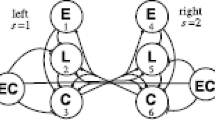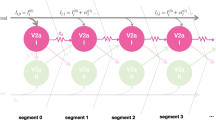Abstract
A method of estimating coupling strength between two neural oscillators based on their spikes trains (Kiemel and Cohen, J. Comput. Neurosci. 5: 267–284, 1998) is tested using simulated data and then applied to experimental data from the central pattern generator (CPG) for swimming in the lamprey. The method is tested using a model of two connectionist oscillators and a model of two endogenously bursting cells. For both models, the method provides useful estimates of the relative strength of coupling in each direction, as well as estimates of total strength. The method is applied to pairs of motor-nerve recordings from isolated 50-segment pieces of spinal cords from adult silver lampreys (Ichthyomyzon unicuspus). The strength and direction of coupling is estimated under control conditions and conditions in which intersegmental coupling between the two recording locations is weakened by hemisections of the spinal cords and/or chambers containing an inhibitory solution that blocks firing in postsynaptic cells. The relevance of these measures in constraining models of the CPG is discussed.
Similar content being viewed by others
References
Arnold L (1974) Stochastic Differential Equations: Theory and Applications. Wiley, New York.
Buchanan JT (1992) Neural network simulations of coupled locomotor oscillators in the lamprey spinal cord. Biol. Cybern. 66: 367-374.
Buchanan JT (1996) Lamprey spinal interneurons and their roles in swimming activity. Brain Behav. Evolut. 48: 287-296.
Cohen AH (1987) Effects of oscillator frequency on phase-locking in the lamprey central pattern generator. J. Neurosci. Meth. 21: 113-125.
Cohen AH, Holmes PJ, Rand RH (1982) The nature of the coupling between segmental oscillators of the lamprey spinal generator for locomotion:Amathematical model. J. Math. Biol. 13: 345-369.
Cohen AH, Wallén P (1980) The neuronal correlate of locomotion in fish. Exp. Brain Res. 41: 11-18.
Dennis JE, Schnabel RB (1983) Numerical Methods for Unconstrained Optimization and Nonlinear Equations. Prentice-Hall, Englewood Cliffs, New Jersey.
Ekeberg Ö (1993) A combined neuronal and mechanical model of fish swimming. Biol. Cybern. 69: 363-374.
Ermentrout GB, Kopell N (1984) Frequency plateaus in a chain of weakly coupled oscillators, I. SIAM J. Math. Anal. 15: 215-237.
Grillner S, Matsushima T, Wadden T, Tegnér J, El Manira A, Wallén P (1993) The neurophysio-logical bases of undulatory locomotion in vertebrates. Semin. Neurosci. 5: 17-27.
Grillner S, Wallén P, Hill R, Cangiano L, El Manira A (2001) Ion channels of importance for the locomotor pattern generation in the lamprey brainstem-spinal cord. J. Physiol. 533: 23-30.
Guan L, Kiemel T, Cohen AH (2001) Impact of movement and movement-related feedback on the lamprey central pattern generator for locomotion. J. Exp. Biol. 204: 2361-2370.
Harvey AC (1990) The Econometric Analysis of Time Series. MIT Press, Cambridge, MA.
Hochberg Y, Tamhane AC (1987) Multiple Comparison Procedures. Wiley, New York.
Karr AF (1991) Point Processes and Their Statistical Inference. Dekker, New York.
Kiemel T, Cohen AH (1998) Estimation of coupling strength in regenerated lamprey spinal cords based on a stochastic phase model. J. Comput. Neurosci. 5: 267-284.
Mellen N, Kiemel T, Cohen AH (1995) Correlational analysis of fictive swimming in the lamprey reveals strong functional intersegmental coupling. J. Neurophysiol. 73: 1020-1030.
Miller WL, Sigvardt KA (2000) Extent and role of multisegmental coupling in the lamprey spinal locomotor pattern generator. J. Neurophysiol. 83: 465-476.
Pikovsky A, Rosenblum M, Kurths J (2001) Synchronization. A Universal Concept in Nonlinear Sciences. Cambridge University Press, Cambridge, England.
Rosenblum MG, Pikovsky AS (2001) Detecting direction of coupling in interacting oscillators. Phys. Rev. E 64: 045202/1-4.
Rovainen CM (1974) Synaptic interactions of identified nerve cells in the spinal cord of the sea lamprey. J. Comp. Neurol. 154: 189-206.
Rovainen CM (1985) Effects of groups of propriospinal interneurons on fictive swimming in the isolated spinal cord of the lamprey. J. Neurophysiol. 54: 959-977.
Sherman A (1994) Anti-phase, asymmetric and aperiodic oscillations in excitable cells-I. Coupled bursters. Bull. Math. Biol. 56: 811-835.
Sherman A, Rinzel J (1992) Rhythmogenic effects of weak electronic coupling in neuronal models. Proc. Natl. Acad. Sci. USA 89: 2471-2474.
Sørensen M (1991) Likelihood methods for diffusions with jumps. In: NU Prabhu, IV Basawa, eds. Statistical Inference in Stochastic Processes. Dekker, New York, pp. 67-105.
Wallén P, Ekeberg Ö, Lansner A, Brodin L, Tråvén H, Grillner S (1992) A computer-based model for realistic simulations of neural networks. II. The segmental network generating locomotor rhythmicity in the lamprey. J. Neurophysiol. 68: 1939-1950.
Williams TL (1992) Phase coupling by synaptic spread in chains of coupled neuronal oscillators. Science 258: 662-665.
Williams TL, Bowtell G (1997) The calculation of frequency-shift functions for chains of coupled oscillators, with application to a network model of the lamprey locomotor pattern generator. J. Comput. Neurosci. 4: 47-55.
Williams TL, Sigvardt KA (1994) Intersegmental phase lags in the lamprey spinal cord: Experimental confirmation of the existence of a boundary region. J. Comput. Neurosci. 1: 61-67.
Williams TL, Sigvardt KA, Kopell N, Ermentrout GB, Remler MP (1990) Forcing of coupled nonlinear oscillators: Studies of intersegmental coordination in the lamprey locomotor central pattern generator. J. Neurophysiol. 64: 862-871.
Author information
Authors and Affiliations
Rights and permissions
About this article
Cite this article
Kiemel, T., Gormley, K.M., Guan, L. et al. Estimating the Strength and Direction of Functional Coupling in the Lamprey Spinal Cord. J Comput Neurosci 15, 233–245 (2003). https://doi.org/10.1023/A:1025868910179
Issue Date:
DOI: https://doi.org/10.1023/A:1025868910179




